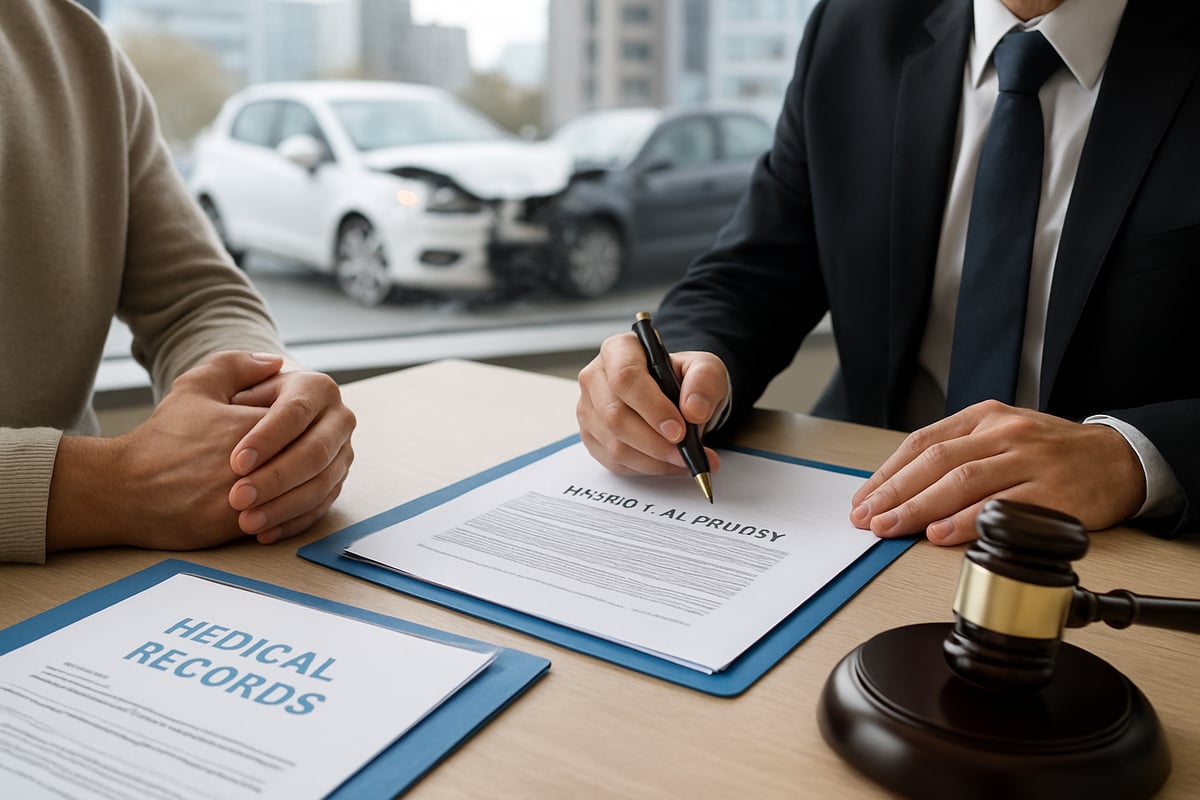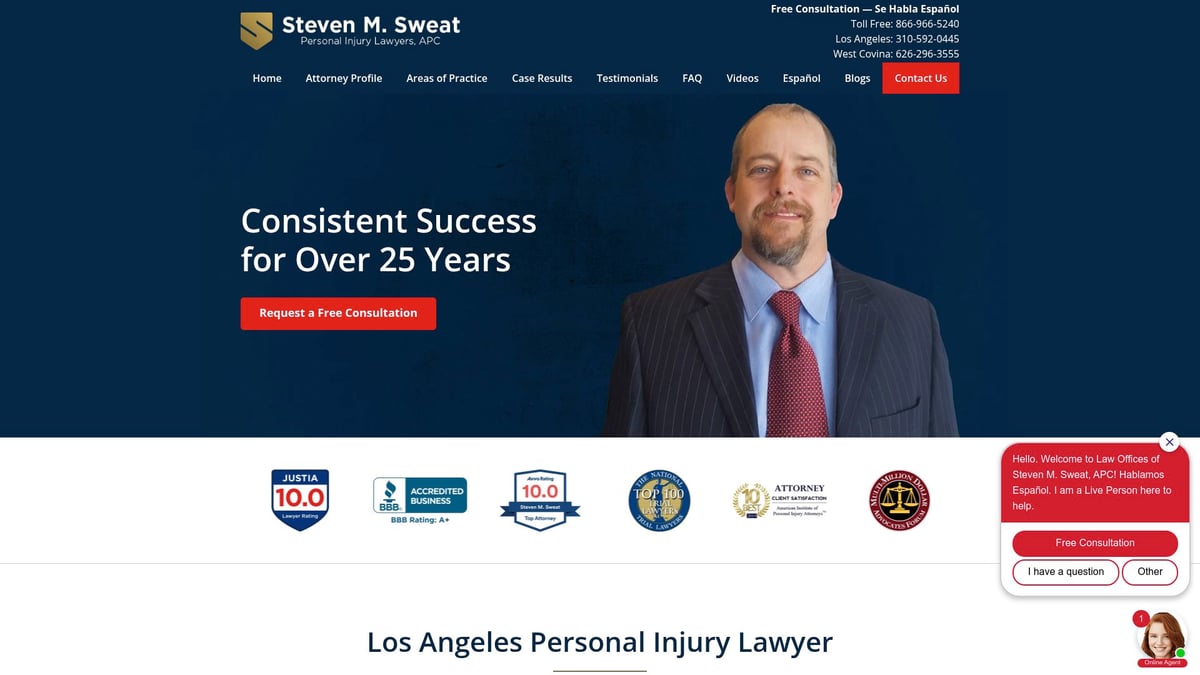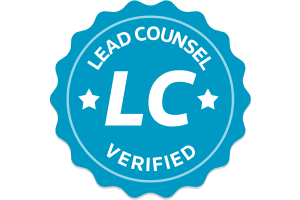- Free Consultation: 866-966-5240 Tap Here To Call Us
Personal Injury Guide: Understanding Your Rights in 2025
Imagine facing a life-changing accident and feeling lost about your rights. Each year, over 400,000 personal injury claims are filed in the United States, yet many people miss out on the compensation they deserve simply because they do not fully understand the process.
This guide will empower you to navigate personal injury law in 2025 with confidence. You will learn what qualifies as personal injury, types of claims, your legal rights, how the claims process works, how compensation is calculated, and what changes to expect this year.
Read on to protect your interests, maximize your outcome, and ensure you know every step to take after an injury.
What is Personal Injury? Definitions and Key Concepts
Understanding the fundamentals of personal injury law is essential for anyone seeking justice after an accident. This area of law centers on harm to your body, mind, or emotions, not your property. Unlike property damage, personal injury involves physical or psychological harm that results from another party’s actions.
Personal injury law is rooted in tort law, which allows you to seek compensation for harm caused by negligence, strict liability, or intentional acts. There are two main sources of these laws: common law, developed by judges over centuries, and statutory law, created by legislatures. For example, if you suffer whiplash in a car accident, that’s considered a personal injury, not property damage. Historically, personal injury cases were rare before the Industrial Revolution, but they surged by over 40 percent in major cities during the early 20th century. If you want to learn more about the basics and process, see the Personal Injury Claims FAQs.
Understanding Personal Injury Law
Personal injury law covers harm to individuals, focusing on physical injuries, emotional distress, or psychological trauma. It does not address property loss. The foundation of personal injury is tort law, which includes negligence, strict liability, and intentional acts.
Common law, shaped by court decisions, often guides these cases, while statutory law comes from written legislation. For instance, if you experience whiplash after a car crash, it is a classic personal injury situation. Over time, personal injury cases have become more common, especially as cities and industries expanded.
Common Types of Personal Injury Cases
There are several situations where personal injury claims arise. The most frequent are road traffic accidents, which often result in serious injuries. Other common cases include:
- Workplace injuries and occupational diseases
- Slip and fall or tripping accidents
- Product liability for defective products
- Medical malpractice and dental negligence
- Assault and intentional harm
- Toxic torts, such as chemical exposure
Each scenario involves unique legal considerations, but they all center on harm to a person rather than property.
Who Can File a Personal Injury Claim?
A personal injury claim can be filed by anyone who has suffered harm due to another’s actions. This includes:
- Injured individuals, known as plaintiffs or claimants
- Family members in wrongful death cases
- Minors or incapacitated persons, with claims filed by guardians
- Employees hurt at work, either through workers’ compensation or third-party claims
For example, a spouse may file for loss of consortium if their partner is severely injured. Eligibility depends on the relationship to the injured party and the circumstances of the event.
Legal Basis for Liability
Liability in personal injury cases is determined by several legal principles. The most common is negligence, which requires showing that the defendant owed a duty, breached it, caused the injury, and resulted in damages.
Strict liability applies when harm results from defective products or hazardous activities, even without proving negligence. Intentional torts, such as assault or battery, involve deliberate harm. States differ in how they handle fault; some use comparative negligence, reducing compensation if the plaintiff shares blame, while others use contributory negligence, which may bar recovery entirely. For example, if you are found partially at fault, your compensation may be reduced accordingly.
Your Legal Rights After a Personal Injury in 2025
Suffering a personal injury can be overwhelming, but knowing your legal rights is essential for protecting your interests in 2025. The law provides a framework to ensure fair compensation, access to justice, privacy, and protection from unfair practices after an injury. Let’s break down your most important rights under modern personal injury law.
Right to Compensation
After experiencing a personal injury, you have the right to seek compensation for your losses. This includes reimbursement for medical expenses, both immediate and ongoing, as well as coverage for lost wages and reduced earning capacity. Compensation may also address pain and suffering, emotional distress, and any property damage linked to the incident.
For example, if you develop chronic back pain following a car accident, your settlement could cover future treatments and therapy costs. Personal injury law ensures you are not left to shoulder the financial burden alone, allowing you to focus on recovery and rebuilding your life. Understanding your compensation rights is the foundation of every claim.
Right to Legal Representation
You are entitled to legal representation throughout the personal injury claims process. Most attorneys offer free initial consultations and work on a contingency fee basis, meaning you pay only if your case is successful. Specialized personal injury lawyers bring expertise and negotiation skills that can significantly improve your outcome.
If you ever feel dissatisfied, you have the right to change attorneys. Statistics show that most successful personal injury claims involve legal representation, highlighting the importance of professional guidance. A skilled attorney can navigate complex legal issues, safeguard your interests, and maximize your compensation.
Statute of Limitations and Time Limits
Every personal injury claim is subject to strict deadlines, known as statutes of limitations, which typically range from two to three years depending on the state. Exceptions exist for minors, delayed discovery of harm, or cases involving fraud. In 2025, several states have updated their deadlines, making it crucial to stay informed about legislative changes.
For instance, California’s statute of limitations for personal injury claims remains subject to recent amendments. To keep up with ongoing changes and ensure your claim is timely, review the latest California Personal Injury Law Updates. Missing a deadline can mean losing your right to compensation, so act promptly and seek legal advice early.
Right to Privacy and Medical Records
Your right to privacy is protected throughout the personal injury process. Sensitive health information is safeguarded under laws such as HIPAA and state privacy regulations. Insurers and opposing parties cannot access your medical records without your explicit consent, and only relevant information should be disclosed.
Unauthorized sharing of your records may lead to legal penalties for the responsible party. Always review any requests for information carefully and consult your attorney before signing releases. Maintaining control over your personal information helps preserve your dignity and strengthens your personal injury claim.
Right to Fair Settlement and Trial
You have the right to negotiate a fair settlement after a personal injury and to reject offers that do not reflect your true losses. If negotiations stall, you are entitled to take your case to trial before a jury. This legal safeguard ensures that you are not pressured into accepting inadequate compensation.
Only about 5% of personal injury cases proceed to trial, with the vast majority settling out of court. However, if you are dissatisfied with a verdict, you may pursue an appeal. This structured process is designed to provide every claimant with a fair opportunity for justice.
Protection from Retaliation and Bad Faith
The law protects you from retaliation by employers or insurers when you file a personal injury claim. Employers cannot penalize you for asserting your rights, and insurance companies are required to act in good faith, processing claims without undue delay or denial.
If an insurer acts in bad faith, you may have grounds for an additional lawsuit seeking further damages. For instance, wrongful denial of a valid claim can result in significant legal consequences for the insurer. These protections reinforce your confidence to pursue a personal injury claim without fear of unfair treatment.
The Personal Injury Claims Process: Step-by-Step in 2025
Navigating the personal injury claims process in 2025 can feel overwhelming, but understanding each step will help you protect your rights and maximize your compensation. Below, we break down the journey from the moment an injury occurs to the final settlement. Each phase is crucial for building a strong personal injury claim and ensuring you receive fair treatment.
Step 1: Seek Medical Attention and Documentation
Your health and safety come first after any personal injury. Seek prompt medical care, even if symptoms seem minor at first. Immediate treatment creates a crucial medical record that links your injuries to the incident.
Be sure to inform your healthcare provider about how the injury happened. This context will be noted in your records and can support your personal injury claim. Keep copies of all medical reports, prescriptions, and bills. For example, after a slip and fall, an emergency room visit and thorough documentation can become key evidence.
Document ongoing symptoms and follow all treatment recommendations. Consistent medical care shows the seriousness of your personal injury and helps establish damages.
Step 2: Report the Incident and Gather Evidence
Reporting the incident quickly is vital when pursuing a personal injury claim. Notify all relevant parties, such as your employer, property owner, or the police, depending on the situation.
Collect evidence while it is fresh. Take photos of the scene, your injuries, and any property damage. Secure witness statements with contact information. Preserve any physical evidence, such as damaged products or clothing.
A police report is especially important in car accidents or assaults. This official documentation strengthens your personal injury case and can help resolve disputes about what happened. Keep all records organized for easy access.
Step 3: Consult a Personal Injury Attorney
Early legal advice can make a significant difference in the outcome of your personal injury case. Schedule a consultation with a lawyer who specializes in personal injury law. Look for experience, client reviews, and a track record of success with similar claims.
During your meeting, ask about the strengths and weaknesses of your case. Discuss fee structures and what to expect throughout the process. Many attorneys offer free evaluations, like the Free Evaluation of Personal Injury Claims service, which can help you understand your options without upfront cost.
Having a knowledgeable attorney increases your chances of fair compensation and ensures your rights are protected during every stage of your personal injury claim.
Step 4: Filing the Claim
Once you have gathered evidence and consulted a lawyer, the next step is to file your personal injury claim. This usually involves notifying the responsible party’s insurance company and submitting detailed documentation, including medical bills and accident reports.
Your attorney will help you prepare a comprehensive claim package. Notify all potentially liable parties to preserve your rights. For example, if a car accident caused your injury, you might need to file with both your auto and health insurers.
Timely filing is essential. Missing deadlines can jeopardize your personal injury case, so act promptly and keep copies of all communications for your records.
Step 5: Investigation and Negotiation
After your personal injury claim is filed, the insurance company will launch an investigation. They may request statements, review medical records, and consult experts to assess the case.
Expect negotiation tactics from insurers, such as low initial offers or requests for additional evidence. Your attorney will counter these strategies by presenting strong evidence and advocating for your interests.
Most personal injury claims settle during this stage. Settlement times can range from a few months to more than a year, depending on the complexity of the case and the willingness of both sides to compromise.
Step 6: Litigation and Trial (if necessary)
If negotiations fail, your personal injury claim may proceed to litigation. This formal process involves filing a lawsuit and entering the discovery phase, where both sides exchange evidence, take depositions, and may use expert testimony.
The trial itself includes jury selection, opening statements, presentation of evidence, and closing arguments. A verdict will determine liability and compensation. If you are dissatisfied with the outcome, you have the right to appeal.
While most personal injury cases settle before trial, being prepared for litigation ensures you are ready to pursue the best possible result for your claim.
Step 7: Receiving Compensation and Post-Settlement Steps
After a successful personal injury claim, settlement funds are disbursed. These funds typically cover medical bills, attorney fees, and other costs. Your attorney will help resolve any outstanding medical liens or insurance claims.
Understand the tax implications of your settlement. Most compensatory damages for physical injuries are non-taxable, but exceptions exist for punitive damages or interest. You may choose between a lump sum or structured settlement, depending on your needs.
Careful management of your personal injury compensation ensures your financial recovery aligns with your long-term interests and well-being.
Calculating Damages and Types of Compensation
Understanding how damages are calculated in a personal injury case is critical to securing fair compensation. Damages cover various losses, from financial costs to emotional impacts. Each category addresses a different aspect of harm, ensuring that victims receive comprehensive relief for their injuries.
Economic Damages
Economic damages form the backbone of most personal injury claims. These damages compensate for tangible financial losses that result from an incident.
Common components include medical bills, both immediate and long term, as well as rehabilitation and ongoing care. Lost wages are another key consideration, covering time away from work and diminished future earnings. Property damage, such as vehicle repairs after a crash, also falls into this category.
For example, a personal injury case involving a truck accident might result in $50,000 in medical expenses alone. Economic damages are generally straightforward to calculate, relying on receipts, pay stubs, and repair estimates.
Non-Economic Damages
Non-economic damages address the intangible consequences of a personal injury. These losses are real, though not always easily measured in monetary terms.
Pain and suffering encompasses both physical discomfort and emotional distress. Loss of enjoyment of life compensates for activities or hobbies the victim can no longer pursue. Disfigurement or permanent disability can also lead to significant non-economic awards.
For instance, someone who develops PTSD after an assault may be entitled to compensation for the profound impact on their daily life. While more subjective, non-economic damages play a vital role in personal injury cases.
Punitive Damages
Punitive damages are awarded in select personal injury cases where the defendant’s actions go beyond ordinary negligence. These damages punish especially reckless or intentional conduct.
The purpose is to deter similar behavior in the future and send a strong message to others. States may impose caps or specific limitations on punitive awards, especially as of 2025. Not every personal injury claim qualifies for punitive damages, but they can be significant when gross negligence is proven.
For example, a court might order a large punitive award in a drunk driving case where the harm was preventable and egregious.
Factors Affecting Compensation Amounts
Several factors influence the final compensation in a personal injury case. The severity and permanence of the injury are primary considerations, as more serious injuries typically result in higher awards.
Comparative negligence is another key factor, where the plaintiff’s own fault can reduce compensation. The quality of evidence and the skill of legal representation often impact case outcomes. Insurance policy limits may also restrict the total recovery.
According to Personal Injury Law Statistics 2025, the average settlement in the United States ranges from $24,000 to $75,000. Understanding these factors helps set realistic expectations.
Tax Implications of Personal Injury Settlements
Tax rules for personal injury settlements can be complex, but most compensatory damages are non-taxable. This includes payments for physical injuries or illnesses.
However, there are exceptions. Interest earned on settlements, punitive damages, and compensation for emotional distress without a physical injury may be taxable. Properly structuring a settlement is crucial to avoid unexpected tax liabilities.
IRS guidelines for 2025 clarify these distinctions, so consulting a tax professional after a personal injury case is always recommended to ensure compliance and maximize your recovery.
Major Changes and Trends in Personal Injury Law for 2025
Staying ahead of major changes in personal injury law is essential for protecting your rights in 2025. New technologies, legislative reforms, and evolving insurance practices are reshaping how claims are handled and resolved. Understanding these trends helps you prepare for what to expect and how to best pursue your personal injury case. For a comprehensive look at this year’s key developments, you can also review Personal Injury Statistics and Trends 2025.
Technology and Evidence Gathering
Technology now plays a crucial role in personal injury cases. Dashcams, surveillance footage, and wearable devices often provide critical evidence to support or dispute claims. Digital health records allow for faster, more accurate documentation of injuries and treatments, making it easier to prove damages. Social media can also impact credibility, as posts and online activity are increasingly scrutinized during investigations. For example, fitness tracker data can demonstrate physical limitations after an accident, directly affecting the outcome of a personal injury claim.
Legislative and Regulatory Updates
The legal landscape for personal injury continues to evolve. Many states have enacted new statutes affecting claim deadlines and damage caps. Changes to comparative negligence laws can influence the amount of compensation you may receive, depending on each party’s degree of fault. In 2025, some states, such as California and New York, have introduced reforms to clarify or adjust the statute of limitations for certain injuries. These legislative updates are designed to balance the rights of claimants and defendants while ensuring fair access to justice in personal injury matters.
Insurance Industry Shifts
The insurance industry has undergone significant transformation in response to personal injury trends. Insurers are increasingly relying on telemedicine and virtual claim assessments, which can speed up the evaluation process. Artificial intelligence tools are now used to analyze claims, helping detect fraudulent activities but sometimes increasing claim denials due to automated decision-making. Policy coverage requirements have also changed, often in response to new types of injuries or evolving workplace hazards. Staying informed about these shifts is vital when navigating a personal injury claim in 2025.
Trends in Litigation and Settlements
Litigation patterns in personal injury cases are shifting. Jury trials are becoming less common, with a greater emphasis on mediation and arbitration to resolve disputes. There is notable growth in class actions and mass torts, especially involving defective products or medical devices. Average settlement times and amounts are changing, influenced by technology and new legal standards. For more insights into these trends and up-to-date statistics, see Personal Injury Law Statistics 2025. This data helps claimants set realistic expectations for their personal injury case.
Consumer Rights and Advocacy
Consumer advocacy is stronger than ever in the personal injury field. Patient and consumer groups are raising awareness of legal rights through online resources and community outreach. Legislative efforts focus on protecting victims from predatory practices by insurers or employers. New watchdog agencies now monitor insurance company conduct, ensuring compliance with fair claims practices. These changes empower individuals to pursue personal injury claims confidently and seek appropriate compensation for their losses.
Choosing the Right Personal Injury Attorney
Selecting the right personal injury attorney is a crucial decision that can directly impact the outcome of your claim. With the right legal partner, you improve your chances of securing fair compensation and navigating complex legal processes with confidence.
Qualities to Look for in a Personal Injury Lawyer
When searching for a personal injury lawyer, prioritize experience and a successful track record in similar cases. Specialization matters—choose someone who focuses on the type of injury you have, such as auto accidents or workplace incidents.
Review client testimonials and professional ratings to gauge reputation. Effective communication and availability are essential, so ensure the attorney is responsive and clear. For example, a lawyer who has secured multimillion-dollar verdicts in car accident claims can offer valuable insight. Learn more about the process by visiting Car Accident Injury Claims in California.
Questions to Ask During Consultation
During your initial meeting, ask the attorney to assess the strengths and weaknesses of your personal injury case. Inquire about their fee structure, whether contingency, hourly, or flat fee. Clarify who will manage your case—will it be the attorney or a paralegal?
Discuss expected timelines, potential outcomes, and the attorney’s experience with cases like yours. A helpful question is, “What is your success rate in cases similar to mine?” This information helps you make an informed decision.
Steven M. Sweat, Personal Injury Lawyers, APC: Los Angeles Representation
Steven M. Sweat, Personal Injury Lawyers, APC is a highly respected law firm in Los Angeles, specializing in personal injury and wrongful death cases. With over 25 years of experience and hundreds of millions recovered, their team handles auto accidents, workplace injuries, premises liability, and more.
They offer free consultations, bilingual services, and only charge fees if you win. The firm serves clients across California, providing home and hospital visits when needed. Contact them at 866 966 5240 or www.victimslawyer.com for immediate assistance and dedicated representation.
After reading this guide, you now understand your rights and the key steps to take after a personal injury in 2025—from knowing what qualifies as a claim to recognizing the importance of timely action and strong legal representation. If you’re facing uncertainty after an accident in Los Angeles, you don’t have to navigate it alone. The right support can make all the difference in protecting your interests and securing fair compensation. If you’re ready to discuss your situation and get personalized answers, reach out for a Free Consultation No Fee Until We Win.












